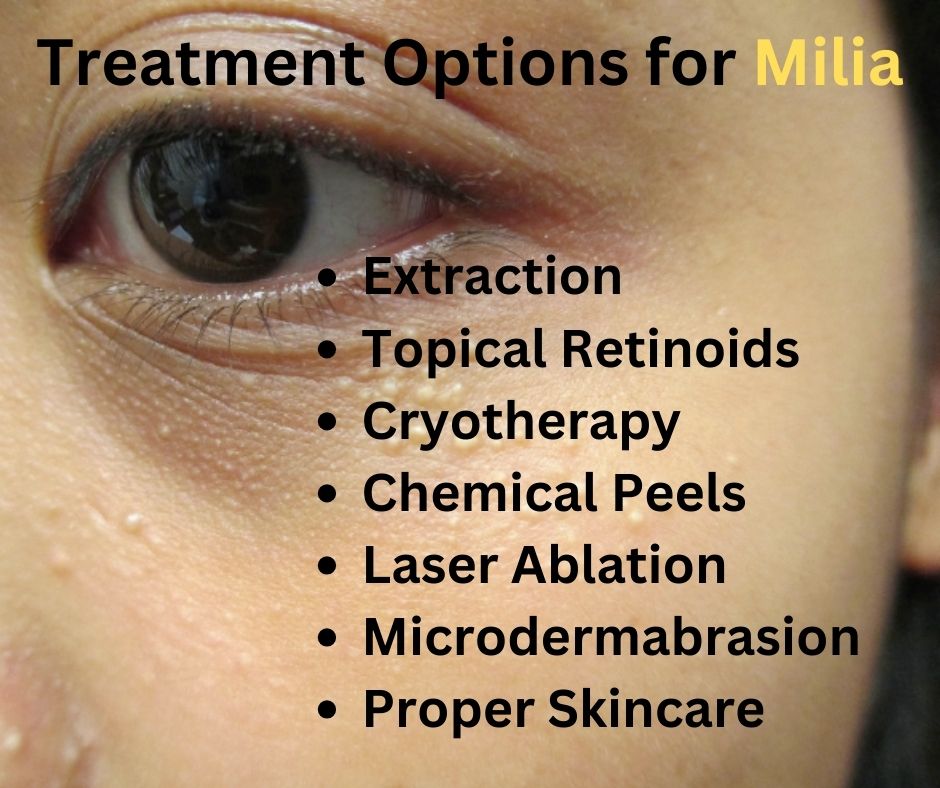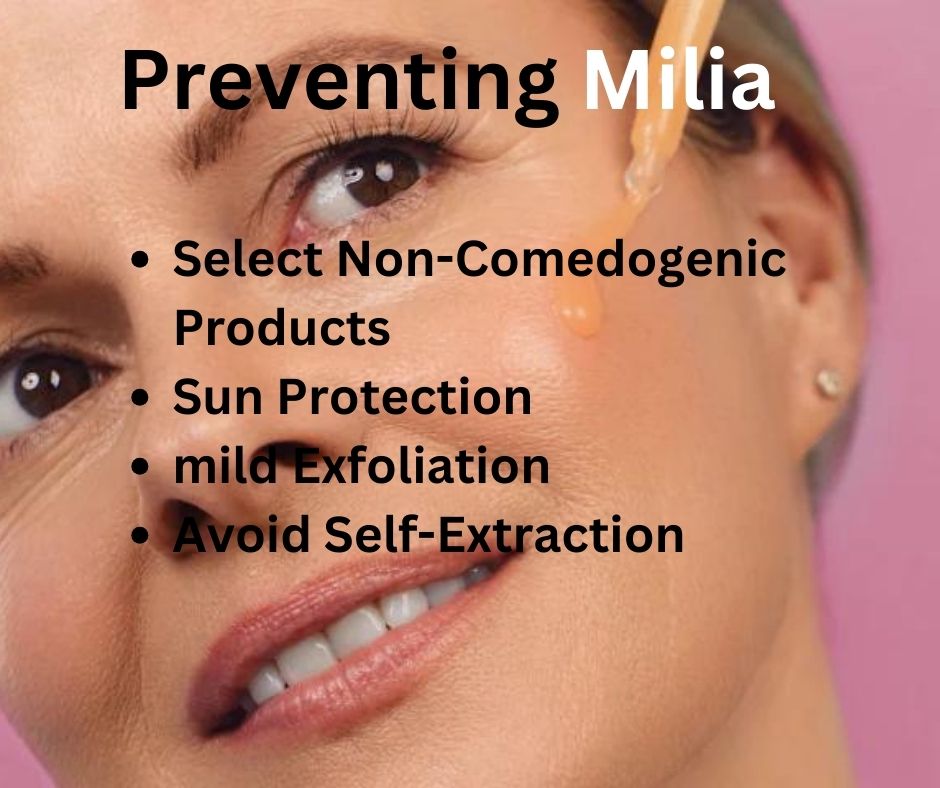Milialar, sometimes called “milk spots,” is a common skin ailment that can afflict individuals of all ages. Although these little white pimples appear to be innocuous, those who get them sometimes find them to be very annoying. To help you comprehend and manage Milia better, we will go through its definition, symptoms, causes, and available treatments in this post.
What is Milia?

Milia are tiny, white, or yellowish cysts that can grow on different regions of the body but usually show up on the face. They are frequently confused for pimples or whiteheads, although they are not the same. Milia are microscopic, superficial cysts that contain keratin, a kind of protein. They are not linked to bacteria or sebum, in contrast to whiteheads or pimples (skin oil). Primary and secondary Milia are the two main varieties of Milia.
- Primary Milia: Usually affecting individuals of all ages, including newborns and adults, they are the most prevalent kind of Milia. The shedding of dead skin cells and skin turnover are frequently associated with primary milia. They often show up on the face, especially in the cheek, nose, and eye areas.
- Secondary Milia: Damage to the hair follicles, sweat ducts, or other skin structures might result in the development of Secondary Milia. Injuries, burns, prolonged sun exposure, and the use of specific skincare products can all result in this damage.
What Causes Milia?

The precise etiology of Milia may differ according to the kind. The following are some typical variables linked to both primary and secondary Milia:
- Skin Cell Retention: When skin cells become stuck in tiny crevices on the skin’s surface, Primary Milia frequently form. Cysts are then formed as these cells solidify.
- Skin Trauma: Damage to the skin’s hair follicles, sweat ducts, or other structures may result in Secondary Milia. Burns, blisters, and strong skincare products can cause this damage.
- Usage of Specific Skincare Products: The development of Milia may be aided by using certain skincare products, particularly thick creams, or lotions. These goods might form a barrier that keeps dead skin cells in place.
- Sun Damage: Excessive exposure to UV radiation from the sun can thicken skin and increase the likelihood of developing Milia.
- Genetic Predisposition: Milia may occur in certain people due to a genetic predisposition.
Also Read – What Hair Care Tips Should You Follow in Your Routine Life?
Symptoms of Milia
Milia has a distinctive look that makes them easier to distinguish in general. The following are the primary signs and symptoms of this skin condition:
- Tiny white or yellow-colored cysts on the epidermis.
- Small bumps, usually measuring 1-2 millimeters.
- They are usually harmless, but if they happen in delicate places, like the eyelids, they might hurt.
- Most frequently observed on the face, particularly in the cheek, nose, and eye areas.
It is crucial to remember that Mila is often painless and has allergic reactions. Although they are mostly a cosmetic issue, some people may find them to be a cause of self-consciousness.
Diagnosis

A detailed examination of the skin’s appearance, the location of the cysts, and perhaps extra tests to confirm the diagnosis or rule out other skin illnesses are all part of the diagnostic process for Mila. Dermatologists or other medical professionals are qualified to carry out this assessment. A closer look at the diagnostic procedure is provided here:
- Visual Examination: Examining the afflicted regions visually is the first step in diagnosing Milia. Dermatologists are experts in recognizing Milia by looking at its distinctive features. Typically, they search for 1-2 millimeter-sized, white, or yellowish-colored cysts. These cysts can appear anywhere on the face, although they are most common around the cheeks, nose, and eyes. Although the cysts are usually harmless, they may hurt if they appear in delicate areas like the eyelids.
- Medical History: Your healthcare practitioner could inquire about your medical history as part of the diagnostic procedure. They could ask about any recent burns, skin injuries, sun exposure, or usage of skincare products that might be linked to the development of Milia. An extensive medical history can be useful in determining the condition’s possible etiology.
- Differential Diagnosis: Milia may occasionally be confused with other skin disorders such as sebaceous hyperplasia, closed comedones, or whiteheads. Healthcare practitioners may carry out a differential diagnosis to guarantee an accurate diagnosis. To rule out other skin disorders, they may evaluate the features of the cysts if there are any associated symptoms, and any possible underlying reasons.
- Skin Biopsy: In rare cases where the diagnosis is unclear, a skin biopsy could be advised. A biopsy involves removing a little sample of tissue from the afflicted region so that it may be examined under a microscope. Milia may be identified using this process, which can also assist in differentiating it from other skin disorders that seem similar.
- Evaluation of Secondary Milia: A dermatologist would probably assess the precise origin of the skin damage if secondary Milia were detected. This might entail going through the patient’s past medical records, talking about the accident or illness that caused Milia, and figuring out the best course of action for therapy.
- Related Symptoms: Although Mila themselves are usually asymptomatic, medical professionals may also ask about any related symptoms, such as redness, swelling, or itching. These signs might be a sign of an infection or other skin problems.
- Accompanying Skin Conditions: Milia may occasionally occur in conjunction with or serve as a sign of underlying skin conditions, such as certain genetic abnormalities. If a medical professional believes there may be an underlying issue, they may suggest doing more testing or speaking with specialists.
It is crucial to remember that for skilled medical professionals, diagnosing Milia is often simple. For the most part, a thorough medical history and visual examination are enough to provide an accurate diagnosis. Following a diagnosis of Milia, the patient and the healthcare professional can talk about possible courses of action and safeguards.
Although Milia is usually benign, it is important to see a dermatologist or other experienced healthcare provider if you have concerns about your skin or believe you may have Milia. They can provide you with a comprehensive assessment and tailored advice on management and treatment.
Also Read – Healthcare Tips to Boost Immunity in the Viral infection
Treatment Options for Milia

Milialar can occasionally go away on their own with time, but there are several treatment options available if they continue or start to bother you cosmetically. The type and location of the Milia, in addition to personal preferences, determine the course of treatment. The following are some typical Milia treatment options:
- Extraction: Using a sterile needle or scalpel, a dermatologist can manually remove Milia. Attempting this treatment at home runs the risk of infection or scarring; it should only be done by a skilled specialist.
- Topical Retinoids: Retinoid creams, available over the counter or by prescription, can hasten the turnover of skin cells and promote the resolution of milia. The use of these products ought to be supervised by a medical practitioner.
- Cryotherapy: Using liquid nitrogen to freeze the Milia, the cysts are forced to peel away. When Milia is not responding to previous treatments, this therapy is frequently employed.
- Chemical Peels: Usually done in a dermatologist’s clinic, chemical peels can help exfoliate the outermost layer of skin, which may facilitate the discharge of Milia.
- Laser Ablation: The cysts can be vaporized using specific kinds of lasers. Although there may be a lengthier recovery time, this therapy is beneficial.
- Microdermabrasion: Over time, this non-invasive technique that exfoliates the skin’s outer layer may aid in the removal of Milia.
- Proper Skincare: Make sure to cleanse your face regularly and stay away from heavy, pore-clogging skincare products. Additionally, a mild exfoliation regimen might aid in preventing Milia.
Before beginning any therapy, it is crucial to speak with a dermatologist. They can offer specialized recommendations depending on your unique situation.
Preventing Milia

It is not always feasible to prevent Milia, particularly when it comes to primary Milia caused by normal skin turnover. You may, however, take the following steps to lower your chance of having Milia:
- Select Non-Comedogenic Products: To lessen the chance of pore obstruction, use skincare and cosmetics products that are branded as “non-comedogenic”.
- Sun Protection: Wear protective clothes and apply sunscreen to shield your skin from prolonged sun exposure. Skin thickening and an increased risk of Milia can result from sun exposure.
- mild Exfoliation: To assist in avoiding the accumulation of dead skin cells, include a mild exfoliation procedure in your skincare routine.
- Avoid Self-Extraction: Refrain from picking or squeezing Milia. Scarring or infection may result from this.
Conclusion
Milialar is a widespread and usually innocuous skin disorder, while it is sometimes an aesthetic problem. A greater understanding of the condition’s origins, symptoms, and potential treatments can aid individuals in managing it more effectively. It is essential to speak with a dermatologist if you have Milia and are thinking about receiving treatment. They can offer expert advice and suggest the best course of action. People may have clear, healthy skin by managing Mila successfully with the correct treatment and preventative methods.
Also Read – Need Plastic Surgery to Improve Your Looks? | Here is a complete guide
